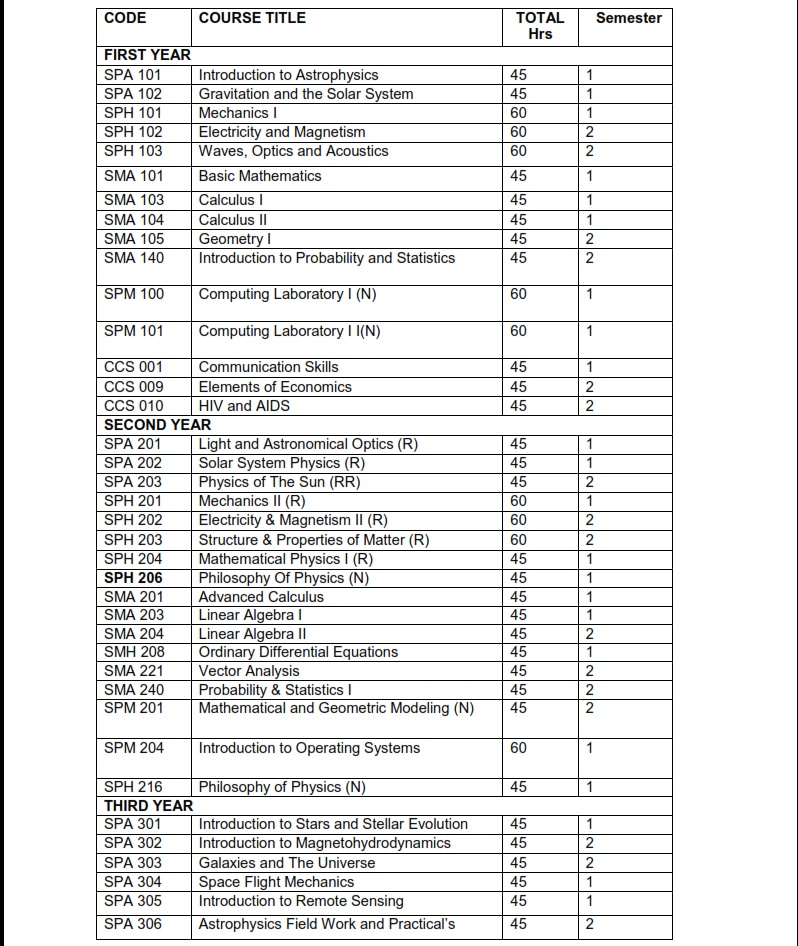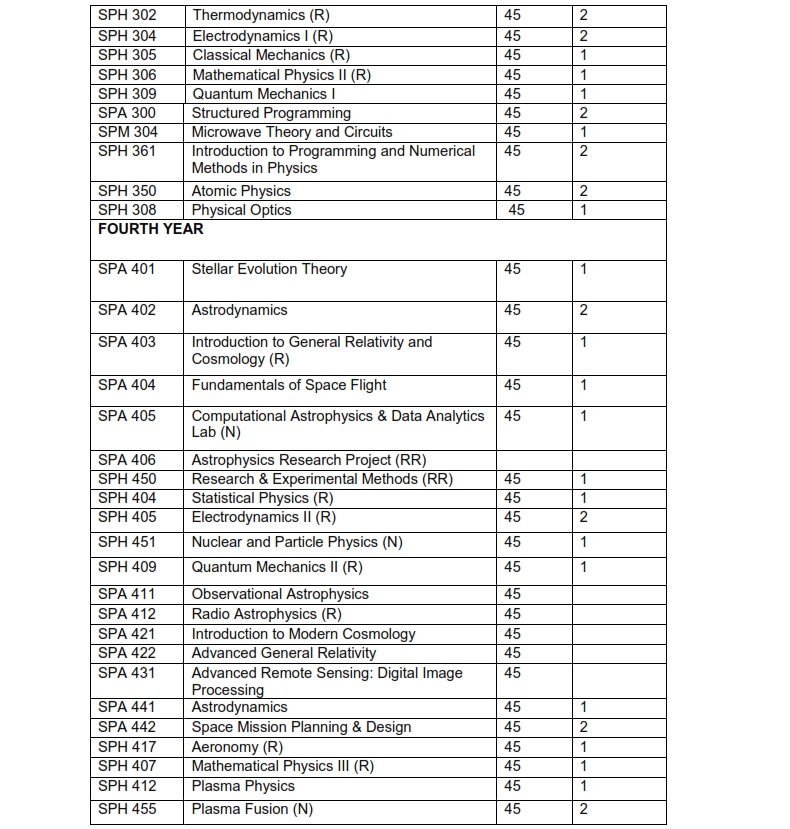Overview
Philosophy of the Programme
The philosophy of the programme is to foster excellence in Space Sciences and Astrophysics observations; creativity and innovation, academic freedom, professionalism and integrity through quality scholarship and research. This is in line with the University of Nairobi philosophy which is guided by the need to connect to and inspire the Kenyan community, to provide leadership and stewardship and to give hope and faith to the Kenyan society so that it can excel in the whatever it chooses to do so with passion, moral responsibility and a strong sense of patriotism.
Rationale of the Programme
This is a revised B.Sc Program that aims at providing sufficient basis for specialization in Astrophysics and Space Science. It captures the strengths of the Department in terms of expertise and infrastructure Astrophysics and Space Science. Some of the units in the old program have been re-structured or re-packaged while a number of new units have been introduced to enhance the areas of specialization.
Goal of the Programme
The B.Sc. Astrophysics and Space Science degree program is designed to train high-skilled graduates with relevant skills to work in the areas of Basic and Applied Space Sciences, such as Satellite Space Stations (e.g., San Marco in Malindi), Astronomical observatories and Aeronautical Engineering Departments and Remote Sensing. The mounting of this course is meant to offer a basis for serious capacity building to attain the critical mass of expertise needed for the development of Space Science and astronomical observatories in Kenya, which ultimately will be critical to the establishment of a Kenya Space Agency and a Kenya Astronomical Observatory. Currently Kenya is engaged in joint Space Science activities, with the Italian Government through the San Marco Project in Malindi. Kenya is also one of the 8 partner countries that will host radio Astrophysics dishes for the Square Kilometer Array telescope (SKA)- which will be the largest telescope in the world. Kenya is also in the process of converting redundant telephony satellite dishes at Mt. Longonot to Radio Telescopes, for use as part of the African Very Long Base Interferometry Network (African VLBI). To enrich and improve quality and relevance of this program, the Department maintains close links with the needs of practice through scholarship, research and consultancy with key industry players.
Expected Learning Outcomes of the Programme
At the end of the programme, the learner should be able to:
- Demonstrate relevant scientific knowledge, creativity, skills and techniques in solving problems in Astrophysics and Space Sciences
- Apply acquired relevant scientific writing, logical reasoning, and analytical skills
- Utilize acquired knowledge to undertake and solve problems that contribute to the advancement of Astrophysics and Space Sciences,
- Addryess emerging societal issues in industry and academia using acquired knowledge
MODE OF DELIVERY OF THE PROGRAMMES
The programme is offered through both Face to Face and by Open, Distance and e-Learning (ODeL) mode of learning
Face to Face mode of Learning
This delivery mode shall use face to face full time learning through:
- Lectures and tutorials with lecture notes, LCDs, Whiteboards/black boards Instruction Materials and equipment
- Group discussions amongst learners
- Class experimental demonstration/simulation
- Practical laboratory work with laboratory manuals as course materials
Open, Distance Learning, and e-Learning (ODeL)
The Open, Distance and Electronic learning modules are largely home and /or office-based and include:
- Written self-instructional study modules issued at registration time, for example:
- Study course materials like booklets
- Relevant literature
- Interactive devices and self-tests
- Face to face introductory tutorials.
- Mediated technical learning materials for example:
- Audio visual
- E-learning
- Limited face-to-face sessions to provide overview of the course at commencement of semester, mid semester and revision period before examinations.
- Support study centers at the University of Nairobi
- Access to information through computers at the University of Nairobi and other resource centers.
- Use of libraries at the University of Nairobi and other institutions
- Orientation:
- Orientation on ODeL delivery
- Study, reading and computer skills
- Time management and techniques of handling assignments
- Mentorship, guidance and counselling
- Emphasis is on satellite centers that serve as a link between the University and the learner in the following manner: registration, collecting reading materials, collecting results and programmes, examination information, posting timetables and holding meetings.
ATTACHMENT OPPORTUNITIES
Physics students and graduates have attachment opportunities in the following sectors of the economy
- Energy sector such as Kenya power and lighting company (KPLC), Kenya power generating companies (such as Olkaria etc)
- Telecommunications and IT industry
- Satellite Space Stations (e.g., San Marco in Malindi)
- Aviation Industry such as Kenya Airways.
- Government agencies such as the Ministry of Public Works (Materials Branch), Kenya Bureau of Standards (KEBS), Kenya Industrial Research Development institute (KIRDI), Kenya Intellectual Property Institute (KIPI).
Contact Person
For more information, contact
The Chairman,
+254794587955, +254204924119
Structure
The programme shall entail university common units, core programme units and electives in all the specialization areas of Physics.


- Third and fourth year of study, candidates will be expected to undertake a total of 12 approved courses covering various areas of Physics and Astrophysics.
- NB. 3 hours of practicals are equivalent to 1 lecture hour.
Duration and Structure of the Programme
The program shall normally run for four (4) academic years (8 semesters). Common University regulations shall apply. Maximum duration of the course shall be eight (8) years.
- In the first year of study, each student will be required to take fourteen (14) units which are inclusive of three (3) university common courses.
- In the second year of study, each student will be required to take fourteen (14) units.
- In the third year of study, each student will be required to take eleven (11) core units and at least one (1) elective.
- In the fourth year of study, each student will be required to take ten (10) core units and at least two (2) electives.
- During the fourth year, candidates will undertake research project (SPH 420) under supervision of a member of staff. The project will be done throughout the second semester of the academic year at the end of which the candidate will be expected to submit a written report and orally present their results before a panel of examiners.
Admission Requirements
A candidate wishing to register for a Bachelor of Science degree in Astrophysics and Space Science must have attained the minimum University of Nairobi and School of Physical Sciences entry requirements. In addition, the candidate must have any of the following:
- Kenya Certificate of Secondary Education (KCSE) or equivalent qualifications recognized by the University of Nairobi Senate, with minimum mean grade of C+ (C plus) and C+ passes in at least three science subjects two of which must be Mathematics and Physics.
- Kenya Advanced Certificate of Education (KACE) or equivalent qualification with at least two principal passes in science subjects.
- A science/technology based degree or its equivalent from an institution accredited by the Commission for University Education.
(vii) Candidates who may not have fulfilled conditions in (i) above may be considered for admission provided they present evidence of having undertaken and passed relevant bridging courses from an institution recognized by the University and MUST have scored a minimum mean grade of C+ (C plus) and at least grade C in the subject(s) for which bridging has been undertaken.
Careers
-
Trainnings in this area is designed to train graduates who will have the skills to work in Satellite Space Stations (e.g., San Marco in Malindi), Astronomical Observations, Astronautics and Aeronautical Engineering Departments and Remote Sensing. Graduates have opportunities in:
- Astronomical Observatories
- Space Science Centres and Institutes
- Telecommunication Industries
- Aviation Industry.
- Military
- Energy Sector – to warn of power outages occasioned by solar flares and advice on appropriate remedial measures.
- Disaster and Emergency Sectors (i.e., application of earth observation techniques- remote sensing to assess damage due to floods, bush fires, forest depletion and wildlife monitoring)
Fees and Funding
| BACHELOR OF SCIENCE IN ASTRONOMY AND ASTROPHYSICS - I44 | |||
| YEAR 1 -12UNITS | |||
| Semester 1 | Semester 2 | TOTALS | |
| TUITION | 144,000 | 144,000 | 288,000 |
| EXAMINATION (PER UNIT @1000) | 6,000 | 6,000 | 12,000 |
| ICT SERVICES - (PER YEAR) | 7,000 | 0 | 7,000 |
| REGISTRATION (PER SEMESTER@2250) | 2,250 | 2,250 | 4,500 |
| ID CARD ( PER YEAR) | 1,000 | 0 | 1,000 |
| CAUTION - (ONCE) | 5,000 | 5,000 | |
| STUDENT ORGANISATION(PER YEAR) | 1,000 | 1,000 | |
| MEDICAL FEE (PER YEAR) | 6,500 | 6,500 | |
| ACTIVITY-( PER YEAR) | 2,000 | 2,000 | |
| LIBRARY (PER YEAR) | 4,000 | 4,000 | |
| Total- Astronomy Year 1 | 178,750 | 152,250 | 331,000 |
| YEAR 2 -12UNITS | |||
| Semester 1 | Semester 2 | TOTALS | |
| TUITION | 144,000 | 144,000 | 288,000 |
| EXAMINATION (PER UNIT @1000) | 6,000 | 6,000 | 12,000 |
| REGISTRATION (PER SEMESTER@2250) | 2,250 | 2,250 | 4,500 |
| ICT SERVICES - (PER YEAR) | 7,000 | 0 | 7,000 |
| ID CARD ( PER YEAR) | 1,000 | 1,000 | |
| STUDENT ORGANISATION(PER YEAR) | 1,000 | 1,000 | |
| MEDICAL FEE (PER YEAR) | 6,500 | 6,500 | |
| ACTIVITY-( PER YEAR) | 2,000 | 2,000 | |
| LIBRARY (PER YEAR) | 4,000 | 4,000 | |
| Total- Astronomy Year 2 | 173,750 | 152,250 | 326,000 |
| YEAR 3 -10UNITS | |||
| Semester 1 | Semester 2 | TOTALS | |
| TUITION | 144,000 | 144,000 | 288,000 |
| EXAMINATION (PER UNIT @1000) | 5,000 | 5,000 | 10,000 |
| REGISTRATION (PER SEMESTER@2250) | 2,250 | 2,250 | 4,500 |
| ICT SERVICES - (PER YEAR) | 7,000 | 7,000 | |
| ID CARD ( PER YEAR) | 1,000 | 1,000 | |
| STUDENT ORGANISATION(PER YEAR) | 1,000 | 1,000 | |
| MEDICAL FEE (PER YEAR) | 6,500 | 6,500 | |
| ACTIVITY-( PER YEAR) | 2,000 | 2,000 | |
| LIBRARY (PER YEAR) | 4,000 | 4,000 | |
| Total- Astronomy Year 3 | 172,750 | 151,250 | 324,000 |
| YEAR 4 -10UNITS | |||
| Semester 1 | Semester 2 | TOTALS | |
| TUITION | 144,000 | 144,000 | 288,000 |
| EXAMINATION (PER UNIT @1000) | 5,000 | 5,000 | 10,000 |
| REGISTRATION (PER SEMESTER@2250) | 2,250 | 2,250 | 4,500 |
| STUDENT ORGANISATION(PER YEAR) | 1,000 | 1,000 | |
| ICT SERVICES - (PER YEAR) | 7,000 | 7,000 | |
| ID CARD ( PER YEAR) | 1,000 | 1,000 | |
| MEDICAL FEE (PER YEAR) | 6,500 | 6,500 | |
| LIBRARY (PER YEAR) | 4,000 | 4,000 | |
| ACTIVITY-( PER YEAR) | 2,000 | 2,000 | |
| Total- Astronomy Year 4 | 172,750 | 151,250 | 324,000 |
| Grand TOTALS | 1,305,000 |
